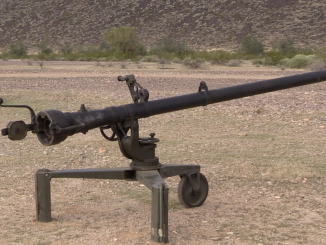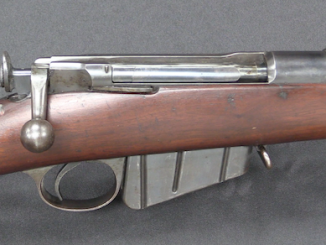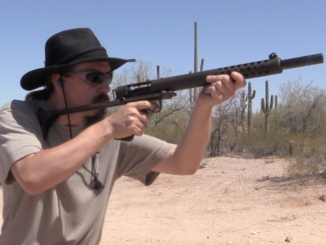George Hyde was a gun designer who is due substantial credit, but whose name is rarely heard, because he did not end up with his name on an iconic firearm. Hyde was a German immigrant to the United States in 1927 who formed the Hyde Arms Company and started designing submachine guns. His first was the Model 33, which we have here today. This quickly evolved into the Model 35, which was tested by Aberdeen Proving Grounds in the summer of 1939. It was found to have a number of significant advantages over the Thompson, but also some durability problems. The problems could probably have been addressed, but Hyde (who had gone from working as shop foreman at Griffin & Howe to later becoming chief designer for GM’s Inland division during WWII) had already moved on to a better iteration. His next design was actually adopted as the M2 to replace the Thompson, but production problems caused it to be cancelled. The M3 Grease Gun was chosen instead, and Hyde had designed that as well. He was also responsible for the design of the clandestine .45 caliber Liberator pistol.
The Hyde Model 33 is a blowback submachine gun which obviously took significant influence from the Thompson – just look at the front grip, barrel ribs, controls, magazine well, and stock design. However, it was simpler, lighter, and less expensive than the Thompson. It fared better than the Thompson in military mud and dust tests, probably in part because of its unusual charging handle, a long rod mounted in the rear cap of the receiver. This was pulled rearward to cycle the bolt, a bit like the AR15 charging handle. Like the AR15, this setup eliminated the need for an open slot in the receiver. Apparently, however, the handle had a disconcerting habit of bouncing back into the face of the shooter when firing.




wouldnt it have been simpler to create a cheap no frills stamped Thompson for WW2, seems obvious to me , with hindsight.
The Thompson was simplified somewhat, going from the Blish Block delayed blowback to a pure blowback. It was still rather heavy. (Of course, no-one has ever created a piece of equipment which was light enough to satisfy a foot soldier. 🙂
“It was still rather heavy.”
It should be remembered that Thompson become default U.S. sub-machine gun, mainly due to lack of alternative (no other sub-machine gun could be delivered fast enough/in enough quantity), rather than superiority of it design.
It was just heavy (M1928 – 4,9 kg empty) compared even to contemporary .45 sub-machine gun: Halcon M/943 at 4,05 kg (empty).
While cost of manufacture and mass were definitely disadvantage Thompson, ergonomic-wise it should be praised in comparison to WW2 weapons. In area of ergonomics it inspired Australian OWEN sub-machine and post-war Ingram Model 6 POLICE sub-machine gun:
https://modernfirearms.net/en/submachine-guns/u-s-a-submachine-guns/ingram-m6-eng/
Stamped firearms were not a thing in the U.S. (nor almost anywhere) in the 1930s, so there’s a lot to be considered in what would have been “easier.” (It is true that bicycles were being made from stampings as early as the late 1800s and the Ford Motor company was using stamped parts in the early 1900s: https://www.toledosattic.org/97-abstracts/commind/96-facesofsteel)
“Stamped firearms were not a thing in the U.S. (nor almost anywhere) in the 1930s, so there’s a lot to be considered in what would have been “easier.”(…)”
I think M1 Carbine is relevant here, because it was popular U.S. fire-arms, not only in term of raw number of produced overall, but also numbers of manufacturers involved.
According to https://en.wikipedia.org/wiki/M1_carbine#Production
largest producer was the Inland division of General Motors, but many others were made by contractors as diverse as IBM, the Underwood typewriter company, and the Rock-Ola jukebox company.
There are also prices given and M1 Carbine was much cheaper than Thompson:
M1 carbine was also one of the most cost effective weapons used by the United States Military during World War II. At the beginning of World War II the average production cost for an M1 carbine was approximately $45, about half the cost of an M1 rifle at approximately $85 and about a fifth of the cost of a Thompson submachine gun at approximately $225
As side note: Hyde made in 1944 stamped selective-fire weapon for .30 Carbine cartridge https://www.forgottenweapons.com/submachine-guns/hyde-carbine-1944/
Yes good points. During WWII the use of stamped parts for firearms increased quite a bit. The Stg44 and the Sten are perhaps the most famous examples, but there were certainly others. The M-1 Carbine wasn’t a stamped-receiver firearm, but it was produced in vast numbers.
“The M-1 Carbine wasn’t a stamped-receiver firearm, but it was produced in vast numbers.”
And what is interesting, despite big number of manufacturers it still has interchangeable parts.
http://www.uscarbinecal30.com/manufacturers.html
For me, it is testimony of U.S. industry ability to adapt to war condition, as many manufacturers mentioned in above link have not prior experience with production of fire-arms.
I worked for his son George Hyde Jr. He was the one who informed me of this gun. in his home I held his father’s prototype. Also letter from president thanking him for his contribution. This was circa 1980s.When I worked for him.
So strange that the designer of the M3 would be so unknown.
I’m not completely surprised. The Thompson had a much bigger reputation, to the point of overshadowing Hyde’s works.
I’d like to see how the charging handle and bolt interact.
Does anybody know, are there any surviving U.S. M2 SMGs?
Why do the radiator fins on the barrel taper down like that?
Imagine if the US had a naming system like the UK, instead of the numbering system currently in use. The M3 SMG could have gone down in history as the “Hyde” SMG
Second, I think the similarity to the M1921 in layout and, particularly, controls would have made it attractive to militaries. It eases transition training considerably
if both guns are so alike
“The Thompson had a much bigger reputation” I’ve often thought that the popularity of the Thompson was not so much due to the intrinsic qualities it possessed (besides being the only thing available – except for the terrible Reising) but due to the influence of Hollywood’s gangster films on the generation that would fight World War II.